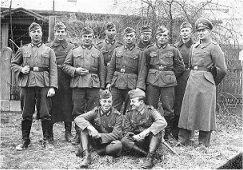The main element of the German army was still fighting in Poland, while a much smaller German force manned their fortified defensive position along the "Siegfried Line" on the French border. While, at the Maginot Line on the other side of the border, British and French troops stood facing them, but there were only some local, minor skirmishes. The British Royal Air Force dropped propaganda leaflets on Germany and the first Canadian troops stepped ashore in Britain, while western Europe was in a strange calm for seven months.
This early period of the war became known as "The Phoney War" as there were very few military operations in Continental Europe. Although the major powers of Europe had declared war on one another, neither side had yet committed to launching a significant attack, and there was relatively little fighting on the ground.
After the "Phoney War", the Battle of France began in earnest on the 10th May 1940. German Army Group 'A' burst through the Ardennes region of Belgium and advanced rapidly to the west, then turned north. To the east, German Army Group 'B' invaded and subdued the Netherlands and advanced westward through Belgium.
A series of Allied counterattacks tried to stem the German advance but failed. After reaching the Channel the Germans swung north along the coast, threatening to capture the ports and trap the British and French forces before they could evacuate to Britain. However, Hitler strangely ordered his German panzer divisions to a halt outside Dunkirk on 24th May 1940. This order was intended to allowed the Germans to consolidate their gains and prepare for a southward advance against the remaining French forces. In addition, the terrain around Dunkirk was considered unsuitable for armour, so the destruction of the Allied forces was initially assigned to the Luftwaffe and the German infantry organised in Army Group 'B'.
On the 25th May 1940, General Lord Gort, the commander of the B.E.F., decided to evacuate British forces from France. From the 25th May to the 28th May, British troops retreated about 30 miles northwest into a pocket along the France-Belgian border extending from Dunkirk on the coast to the Belgian town of Poperinge. The Belgian army surrendered on the 28th May, this was followed the next day by elements of the French 1st Army trapped outside the Dunkirk Pocket.
On the 27th May 1940, "Operation Dynamo" began the evacuation of Allied troops from the area around Dunkirk. The same day the German Panzer divisions were ordered to resume their advance, but improved Allied defences halted their initial offensive, although the remaining Allied forces were compressed into a 5 km wide coastal strip from De Panne through Bray-Dunes to Dunkirk by 31st May 1940.

British troops retreating to Dunkirk (27th May 1940)
The 7th and 8th Territorial Battalions of the Worcestershire Regiment were part of the B.E.F. Both battalions were in the 144th Infantry Brigade of the 48th (South Midland) Division.
The Battalion sailed from Southampton on 14th January, 1940, on the Amsterdam, and at the time security measures were sufficient to ensure that officers and men did not know their port of embarkation. The subsequent disembarkation on 16th January at Le Havre was hardly a happy affair. A high snow-storm was on and they were met by guides who seemed to have no idea whatsoever where to lead their companies.
Click adjacent photo to read their story

7th
Battalion War Diary (May 1940)
Click here to read the War Diary
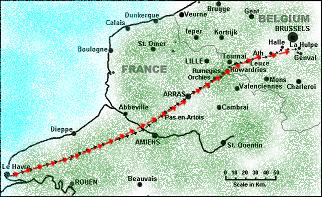
The 8th Battalion landed at Le Havre on the 16th January 1940, and moved up to a concentration area at Tourville before moving on to Moncheaux, near the Belgian frontier, which was reached three days later. At this time the British Expeditionary Force (B.E.F.) was on the left of the Maginot Line, with a neutral Belgium to its front, and had been out of touch with the enemy for months. But the war of mud and static defence was abruptly concluded when Germany invaded the Low Countries, and by 14th May 1940 the 8th Battalion was way up at Dan Hoek on the outskirts of Brussels.
Click adjacent map image to read story
During the retreat, owing to the amount of traffic on the road, the Carrier Platoon soon became separated from the remainder of the battalion, but as they had their rendezvous of Aseghen, they proceeded independently to that town. After searching the neighbourhood for the Battalion they learnt from the Divisional H.Q. in Aseghen that the 144th Brigade was somewhere in the region of Tournai, and so continued our journey in that direction.
2nd Lieutenant (later Captain) E. W. B. Berry who was commanding the carrier platoon wrote an account of their journey.
Click the adjacent image to read his account
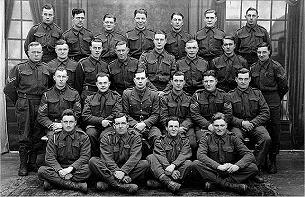
 A
Soldiers view of the withdrawal to Dunkirk
A
Soldiers view of the withdrawal to DunkirkPrivate Bailey a soldier of the Signals Platoon of the 8th Battalion withdrawal to Dunkirk remembers the events from a soldiers view point. He recalls the events from the evening of 15th May 1940, when the 48th Division was ordered forward to reinforce French troops but after marching all night a withdrawal was ordered to Bois des Soignes, (just south of Brussels) returning over ground covered in the night. The next forty-eight hours involved marching mainly at night and resting during the daytime. Rather exhausted, the Battalion arrived at Ninove on May 18th having covered about 60 miles in two and a half days on one meal a day and four hours sleep a night.
Click the adjacent map image to read his full story
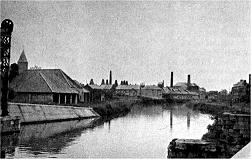 An
Officers view of May 1940
An
Officers view of May 1940The then 2nd Lieutenant E. J. Haywood, an officer who had been commission into the Worcestershire Regiment, was attached to 144th Brigade as a intelligence officer. Both the 7th and 8th battalions of the Worcestershire Regiment were part of this Brigade together with the 5th battalion Gloucestershire Regiment. During the final days of the withdrawal to Dunkirk 2nd Lieutenant E. J. Haywood was appointed Adjutant of the 8th Battalion Worcesters.
In 1946 the then Captain Haywood wrote a fascinating account of his time with both 144th Brigade and the Worcestershire Regiment battalions with the B.E.F. in May 1940.
Click photo of the Escaut River to read his story
2nd Lieutenant J. P. Stiles was part of an advance party of the 8th Battalion Worcestershire Regiment who in March 1940 were despatched to the Saar front to take over a spell of duty in the Ligne de Contacte, the first unit of 144th Brigade to do so. The initial move was to the village of Lorry-de-Metz. The advance party also included Major Geoff Day and the Quarter-Master, Aubrey Graham.
Click here to read the full story
144th Brigade withdrew from the positions it had so tenaciously and successfully held along the Escaut on the night of May 22nd/23rd, occupied posts along the Franco-Belgian frontier on the 23rd, and handed over to French troops on the 24th. On May 25th, the Brigade moved in troop-carrying transport to the Dunkirk area, where Brigade H.Q. opened at Rousbrugge, some 8 miles as the crow flies, S.E. of Dunkirk. The 8th Battalion Worcestershire Regiment was concentrated at Beveren over a mile to the N.E. Sometime later Brigade H.Q. moved to the grounds of a Chateau at Wormhoudt. 2nd Lieutenant E. J. Haywood tells the story of the time.
Click here to read the account by 2nd Lieut. E. J. Haywood
 The Wormhoudt Massacre
(28th May 1940)
The Wormhoudt Massacre
(28th May 1940)Until 1987 it was not known that at least six men from 'D' Company, 8th Battalion Worcestershire Regiment, had been taken prisoners of war, stripped to the waist and their identity discs removed - they and the remnants of The Warwickshires, a number of Cheshires and Gunners of the Royal Artillery, making up a party of some 90 captured men had been forced into the Barn and hand grenades were tossed inside. Bullets were also fired into the Barn. Later those who had survived this ordeal were taken out of the Barn and shot (most of them in the back) in groups of fives to ensure there were no apparent survivors.
During the Dunkirk pilgrimage in May each year the Worcester branch of the Dunkirk Veterans Association joins the Birmingham branch for a service in the Church at Esquelbecq, followed by a march to the top of the hill out of the village, on the Wormhoudt road, to the site of the Barn.
Click on the adjacent photo to read the story
On the 22nd or 23rd May 1940, seven of the 8th Battalion Carriers arrived at La Vacquerie (north of Douai) from Belgium, and were taken under command of M.A.C. Force. The Carriers had as passengers 10 men from the 8th Battalion Worcestershire Regiment. These men were taken on the strength of 138th Infantry Brigade H.Q., and undertook the duties of H.Q. guard, etc.
Click here to read a letter from a Captain of the 138th Brigade with a Testimonial
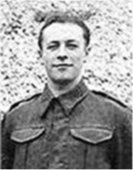 Cpl.
Gilbert W. Wheeler
Cpl.
Gilbert W. Wheeler
Served with 'C' Company of the 8th Battalion. During the retreat to
Dunkirk in May 1940 he was captured near Bambecque on the 29th May. Due to
the lack of information and confusion at the time he family was initially
told he had been killed in action. For the next 5 years he was a POW at
Stalag VIIIB (later renamed Stalag 344). As a POW he worked
at a Cement Factory and Sugar Mill in the region of Upper Silesia.
Click
here or image for story and photos
 Details
of officers who served during the period of May 1940. Additional details and
photos of some of the officers are also included.
Details
of officers who served during the period of May 1940. Additional details and
photos of some of the officers are also included.Click here to view list of officers
 Details
of officers who served during the period of May 1940. Additional details and
photos of some of the officers are also included.
Details
of officers who served during the period of May 1940. Additional details and
photos of some of the officers are also included.Click here to view list of officers
A total of five nations took part in the successful evacuation from Dunkirk – Britain, France, Belgium, Netherlands and Poland.
The necessary defence of the perimeter around Dunkirk led to the loss or capture of a number of British Army units. Between 27th May and 4th June 1940, 338,226 men were evacuated from France including 120,00 French and Belgium troops.
|
Number of men rescued (in chronological order) |
|
| Day (1940) | Number of men |
| 27th May | 7669 |
| 28th May | 17,804 |
| 29th May | 47,310 |
| 30th May | 53,823 |
| 31st May | 68,014 |
| 1st June | 64,429 |
| 2nd June | 26,256 |
| 3rd June | 26,746 |
| 4th June | 26,175 |
| TOTAL | 338226 |
The successful evacuation of more than 338,000 Allied troops from Dunkirk ended the first phase in the Battle for France. It provided a great boost to British morale, but left the remaining French to stand alone against a renewed German assault southwards. German troops entered Paris on the 14th June 1940 and accepted the surrender of France on the 22nd June 1940.
